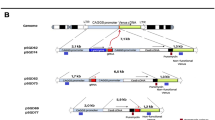Abstract
Synthetic oligonucleotides and DNA fragments of less than 1 kilobase (kb) have been shown to cause site-specific genetic alterations in mammalian cells in culture and in vivo. We have used a lacZ reporter gene system to compare the efficiency of episomal and chromosomal gene repair in human embryonic kidney epithelial cells (HEK293), Chinese Hamster Ovary fibroblasts (CHOK1), human bronchial epithelial cells (16HBE), and mouse embryonic stem (ES) cells. The lacZ gene contains a G to A nucleotide change, (Glu to Lys mutation) that abrogates β-galactosidase activity. We compared the efficiency of different gene repair methods to correct this mutation and restore β-galactosidase activity. We evaluated PCR-generated double-stranded DNA fragments of 0.52–1.9 kb, single-stranded DNA oligonucleotides of 20, 35, or 80 bases containing internal phosphorothioate links, and a 68 base RNA:DNA oligonucleotide. All of the oligonucleotides and DNA fragments showed some gene repair ability with an episomal plasmid. Short DNA fragments of 0.52 kb or greater gave the highest frequencies of episomal gene repair while single-stranded DNA oligonucleotides gave the highest frequency of chromosomal repair. In the context of a chromosomal target, antisense DNA oligonucleotides gave 5-fold higher frequencies of gene repair than their sense counterparts. The RNA:DNA chimeric oligonucleotide gave little or no gene repair on either a chromosomal or episomal target.
This is a preview of subscription content, access via your institution
Access options
Subscribe to this journal
Receive 12 print issues and online access
$259.00 per year
only $21.58 per issue
Buy this article
- Purchase on Springer Link
- Instant access to full article PDF
Prices may be subject to local taxes which are calculated during checkout






Similar content being viewed by others
References
Bradley A et al. Genetic manipulation of the mouse via gene targeting in embryonic stem cells. Ciba Found Symp 1992; 165: 256–269.
Kunzelmann K et al. Gene targeting of CFTR DNA in CF epithelial cells. Gene Therapy 1996; 3: 859–867.
Goncz KK, Kunzelmann K, Xu Z, Gruenert DC . Targeted replacement of normal and mutant CFTR sequences in human airway epithelial cells using DNA fragments. Hum Mol Genet 1998; 7: 1913–1919.
Campbell CR et al. Homologous recombination involving small single-stranded oligonucleotides in human cells. New Biol 1989; 1: 223–227.
Alexeev V, Yoon K . Stable and inheritable changes in genotype and phenotype of albino melanocytes induced by an RNA–DNA oligonucleotide. Nat Biotechnol 1998; 16: 1343–1346.
Bandyopadhyay P et al. Nucleotide exchange in genomic DNA of rat hepatocytes using RNA/DNA oligonucleotides Targeted delivery of liposomes and polyethyleneimine to the asialoglyco-protein receptor. J Biol Chem 1999; 274: 10163–10172.
Igoucheva O, Alexeev V, Yoon K . Targeted gene correction by small single-stranded oligonucleotides in mammalian cells. Gene Therapy 2001; 8: 391–399.
Kmiec EB, Ye S, Peng L . Targeted gene repair in mammalian cells using chimeric oligonucleotides. Genet Eng 2000; 22: 23–31.
Colosimo A et al. Targeted correction of a defective selectable marker gene in human epithelial cells by small DNA fragments. Mol Ther 2001; 3: 178–185.
Kren BT et al. Correction of the UDP-glucuronosyltransferase gene defect in the gunn rat model of Crigler–Najjar syndrome type I with a chimeric oligonucleotide. Proc Natl Acad Sci USA 1999; 96: 10349–10354.
Goncz KK et al. Expression of DeltaF508 CFTR in normal mouse lung after site-specific modification of CFTR sequences by SFHR. Gene Therapy 2001; 8: 961–965.
Kapsa R et al. In vivo and in vitro correction of the mdx dystrophin gene nonsense mutation by short-fragment homologous replacement. Hum Gene Therapy 2001; 12: 629–642.
Alexeev V et al. Localized in vivo genotypic and phenotypic correction of the albino mutation in skin by RNA-DNA oligonucleotide. Nat Biotechnol 2000; 18: 43–47.
Zhang Z et al. Failure to achieve gene conversion with chimeric circular oligonucleotides: potentially misleading PCR artifacts observed. Antisense Nucleic Acid Drug Dev 1998; 8: 531–536.
Igoucheva O Peritz AE, Levy D, Yoon K . A sequence-specific gene correction by an RNA-DNA oligonucleotide in mammalian cells characterized by transfection and nuclear extract using a lacZ shuttle system. Gene Therapy 1999; 6: 1960–1971.
Friedrich G, Soriano P . Promoter traps in embryonic stem cells: a genetic screen to identify and mutate developmental genes in mice. Genes Dev 1991; 5: 1513–1523.
Zambrowicz BP et al. Disruption of overlapping transcripts in the ROSA betageo 26 gene trap strain leads to widespread expression of beta-galactosidase in mouse embryos and hematopoietic cells. Proc Natl Acad Sci USA 1997; 94: 3789–3794.
Chan PP et al. Targeted correction of an episomal gene in mammalian cells by a short DNA fragment tethered to a triplex-forming oligonucleotide. J Biol Chem 1999; 274: 11541–11548.
Thorpe PH, Stevenson BJ, Porteous DJ . Functional correction of episomal mutations with short DNA fragments and RNA–DNA oligonucleotides. J Gene Med 2002; 4: 195–204.
Liu L et al. Strand bias in targeted gene repair is influenced by transcriptional activity. Mol Cell Biol 2002; 22: 3852–3863.
Lukacs GL et al. Size-dependent DNA mobility in cytoplasm and nucleus. J Biol Chem 2000; 275: 1625–1629.
Acknowledgements
We thank Professor Kyonggeun Yoon for her gift of the plasmid pcDNA3.1zeomutlacZ. This work was supported by an MRC studentship awarded to HDN. WHC is supported by the Ford Physiology Fund.
Author information
Authors and Affiliations
Rights and permissions
About this article
Cite this article
Nickerson, H., Colledge, W. A comparison of gene repair strategies in cell culture using a lacZ reporter system. Gene Ther 10, 1584–1591 (2003). https://doi.org/10.1038/sj.gt.3302049
Received:
Accepted:
Published:
Issue Date:
DOI: https://doi.org/10.1038/sj.gt.3302049
Keywords
This article is cited by
-
Progress and prospects: oligonucleotide-directed gene modification in mouse embryonic stem cells: a route to therapeutic application
Gene Therapy (2011)
-
DNA Oligonucleotides and Plasmids Perform Equally as Donors for Targeted Gene Conversion
Biochemical Genetics (2010)
-
A comparison of synthetic oligodeoxynucleotides, DNA fragments and AAV-1 for targeted episomal and chromosomal gene repair
BMC Biotechnology (2009)
-
Delivery and mechanistic considerations for the production of knock-in mice by single-stranded oligonucleotide gene targeting
Gene Therapy (2007)
-
Oligonucleotide-directed gene repair in wheat using a transient plasmid gene repair assay system
Plant Cell Reports (2006)



